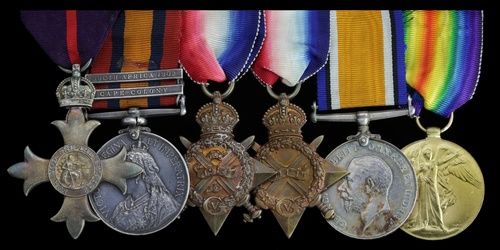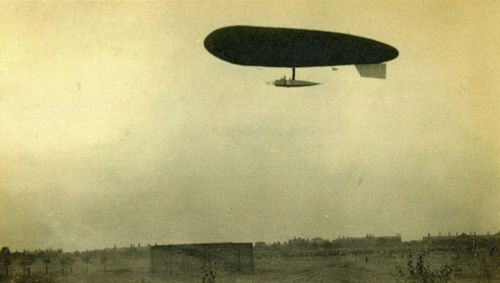Auction: 18002 - Orders, Decorations and Medals
Lot: 509
'On Thursday of last week, the new Army airship "Eta," with Major the Hon. Claud Brabazon in command, and with Lieut. the Hon. James Boyle and Lieut. Hetherington on board, cruised from Farnborough to Colchester, descending for the night in the park of the Benchurch [Berechurch] Hall estate. She returned to Farnborough the following day …'
Flight, 25 October 1913, refers.
A rare pioneer aviator's Great War O.B.E. group of six awarded to Lieutenant-Colonel Hon. C. M. P. Brabazon: a leading light in airships - and founding officer of the Irish Guards - he was seconded to the Royal Flying Corps, Royal Naval Air Service and Royal Air Force
The Most Excellent Order of the British Empire (O.B.E.), Military Division, Officer's 1st type breast badge, silver-gilt, hallmarks for London 1919, in its Garrard & Co. case of issue; Queen's South Africa 1899-1902, 2 clasps, Cape Colony, South Africa 1902 (Lieut. Hon. C. Brabazon, Imp. Yeo.); 1914 Star (Major Hon. C. M. P. Brabazon, I. Gd. Attd. R.F.C.); 1914-15 Star (Sq. Cr. Hon. C. M. P. Brabazon, R.N.); British War and Victory Medals (Wg. Commr. The Hon. C. M. P. Brabazon, R.N.A.S.), together with an Air League of the British Empire lapel badge, gilt and enamel, and an R.A.O.B. breast badge, silver-gilt and enamel, the reverse inscribed 'Presented to Bro. The Hon. Claud Brabazon for Services Rendered', the Queen's South Africa Medal mounted cavalry-style for wear, generally very fine or better (8)
O.B.E. London Gazette 3 June 1919.
Claud Maitland Patrick Brabazon was born on 16 July 1874, son of the 12th Earl of Meath and Lady Mary jane Brabazon, and was educated at Wellington College and Trinity Hall, Cambridge.
Appointed a 2nd Lieutenant in the Mid-Ulster Artillery (Southern Division) in May 1897, Brabazon became a founding officer of the Irish Guards following the regiment's foundation by Queen Victoria in April 1900. He was however seconded to 176th Company, 29th Battalion, Imperial Yeomanry in the Boer War, and served in Cape Colony (Queen's Medal & 2 clasps). He returned home in the Avondale Castle in December 1902.
An early aviator, Brabazon obtained his Royal Aero Club certificate - No. 279 - in September 1912; John Moore-Brabazon, believed to be a kinsman, was the first Englishman to pilot a heavier-than-air machine under power in May 1909. For his own part, Claud Brabazon clearly played an important role in the Army's experimental airship programme, his command of the above cited "Eta" being a case in point. In British Airships 1905-30, Ian Castle states:
'Eta was the Army's last experimental airship. With an envelope capacity of 118,000 cu.ft., Eta was smaller than Delta when it took to the air for the first time in August 1913. Initially it encountered a number of mechanical problems but when these were rectified it became an efficient ship. The rubberized fabric envelope contained two ballonets and was fitted with horizontal side planes with elevators and a vertical lower plane carrying the rudder. The most important innovation on Eta was the suspension system securing the car to the envelope. The six rigging wires from the car each divided into two, then each of these branches divided again into three close to the envelope, where the 36 individual wires were attached to 'D' rings fixed to fan-shaped patches stuck to the envelope with adhesive and then sewn into place. These became known as 'Eta patches' and became a common feature on subsequent non-rigid airships. However, on 1 January 1914, following a government decision, responsibility for all airship development passed from the Army to the Navy (leading to the cancellation of the Army's next airships, Epsilon I and II) and at that point the Army's existing airships, Beta II, Gamma II, Delta and Eta, transferred to naval control.'
Seconded to the Royal Flying Corps on the outbreak of hostilities in August 1914, Brabazon joined G.H.Q. of the 3rd Echelon in the same month. In April 1915, transferred to the Royal Naval Air Service as a Squadron Commander at Roehampton. He afterwards served at R.N.A.S. Mullion, Cornwall and was advanced to Wing Commander in June 1917, the same month in which he was appointed C.O. of the airship base at Pulham, Norfolk.
From February 1918, he acted as C.O. of the airship base at Howden, Yorkshire, following which - that April - he took up post as C.O. of a Kite Balloon section. He was placed on the Retired List as a Lieutenant-Colonel in the early 1920s.
Brabazon died in Co. Wicklow in 1959; sold with copied research.
Subject to 20% VAT on Buyer’s Premium. For more information please view Terms and Conditions for Buyers.
Sold for
£2,500











